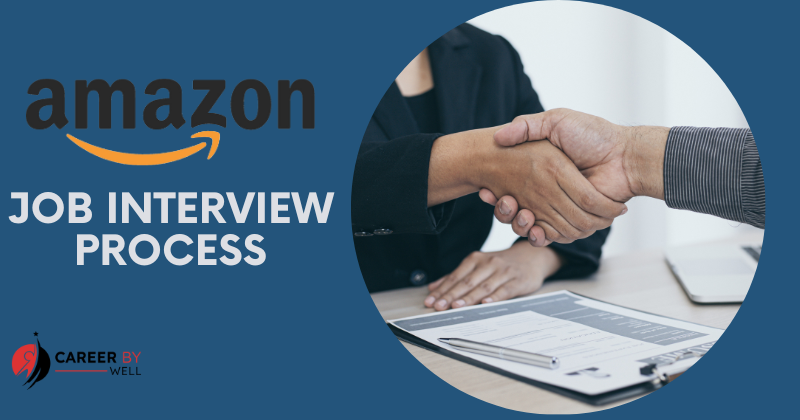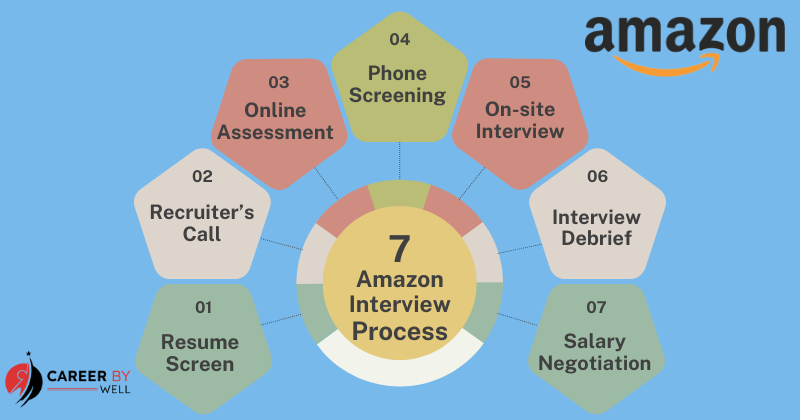Cracking for an Amazon interview is a strategic investment in your career. It provides an opportunity to join a dynamic-innovative company,
The Amazon interview process typically consists of several stages to assess a candidate’s technical skills, problem-solving abilities, and cultural fit within the company.
Remember that the Amazon hiring process can be lengthy and rigorous, so patience is key.
By combining thorough preparation, showcasing your strengths, and aligning with Amazon’s principles, you can increase your chances of standing out in the competitive job market and securing a position at the company.
Why Amazon Job?
Amazon is known for being a pioneer in the tech industry. Working at Amazon provides exposure to cutting-edge technologies and a culture of innovation.
Amazon operates on a global scale, and employees have the chance to work on projects that can have a significant impact around the world.
Working at a company as large and influential as Amazon provides opportunities to network with professionals in various fields.
While Amazon has been known for its demanding work culture, the company has also taken steps to improve work-life balance for its employees. This includes initiatives like flexible work schedules and remote work options.
Amazon Interview Process
The Amazon interview process is known for its thorough and rigorous nature. It typically consists of several stages to assess a candidate’s skills, experience, and cultural fit.
Step 1: Resume Screen
To successfully progress to the initial round of interviews at Amazon, it’s crucial to establish a compelling profile that captures the attention of recruiters.
Whether you submit your application through Amazon’s jobs portal or receive direct outreach from a recruiter via email or LinkedIn, the cornerstone of this process is a meticulously crafted resume.
Amazon’s recruitment team reviews submitted resumes to identify candidates whose qualifications align with the job requirements.
If selected, you’ll be contacted for the next steps. Undoubtedly, a compelling resume secures the coveted interview invitation and sets the stage for a successful progression through subsequent rounds.
Step 2: Recruiter’s Call:
After the approval of your resume, an Amazon recruiter will schedule an approximately 30-minute call with you. This call serves as an opportunity for the recruiter to provide an overview of the overall interview process.
Besides, this is a chance for you to seek clarification on any aspects, such as the timeline, location, or details regarding the job description.
During this initial call, technical questions are generally not included, unless you’re applying for highly technical roles like software engineering.
In such cases, you may encounter a few low-level screening questions assessing your general technical knowledge. However, for most positions, the conversation will focus on typical behavioural and resume-related inquiries.
To excel in the Amazon interview process, it is essential to familiarize yourself with these 16 principles.
This understanding will not only enhance your performance in behavioural interviews but also demonstrate your preparedness and alignment with Amazon’s unique organizational culture.
Take the time to delve into each principle, reflect on how they relate to your experiences, and be ready to articulate examples that showcase your embodiment of these principles in a professional context.
16 Leadership Principal For Amazon
These principles encapsulate the core values and philosophies that guide Amazon’s culture, decision-making processes, and expectations for its leaders.
- Customer Obsession: Leaders prioritize customers, working tirelessly to earn and maintain trust.
- Ownership: Leaders think long-term, act as the owner of the company, and avoid saying ‘That’s not my job.’
- Invent and Simplify: Strong candidates foster innovation, seek ideas from everywhere, and are not hindered by ‘not invented here.’
- Are Right, A Lot: Leaders exhibit strong judgment, seek diverse perspectives, and work to validate their beliefs.
- Learn and Be Curious: Leaders are perpetual learners, always striving to improve and explore new possibilities.
- Hire and Develop the Best: Fine candidates raise the performance bar, recognise exceptional talent, and actively contribute to talent development.
- Insist on the Highest Standards: Desirable candidates uphold relentlessly high standards, continually raising the bar for quality and excellence.
- Think Big: Leaders think differently, communicate bold directions, and look for innovative ways to serve customers.
- Bias for Action: Smart candidates value speed in decision-making, encouraging calculated risk-taking.
- Frugality: Fine candidates accomplish more with fewer resources, promoting resourcefulness and invention.
- Earn Trust: Leaders listen attentively and treat others with respect.
- Dive Deep: Versatile Leaders operate at all levels, stay connected to details, and are sceptical when metrics and anecdotes differ.
- Have Backbone; Disagree and Commit: Leaders respectfully challenge decisions, express conviction, and commit wholeheartedly once a decision is made.
- Deliver Results: Leaders focus on key business inputs, delivering quality and timely results, even in the face of setbacks.
- Strive to be Earth’s Best Employer: Leaders work to create a positive, diverse, and just work environment, leading with empathy and fostering personal success.
- Success and Scale Bring Broad Responsibility: Exellent candidate acknowledge the impact of their actions on the world, emphasizing continuous improvement and leaving things better than they found them.
Step 3: Online Assessment
When progressing through the Amazon interview process, candidates may encounter take-home assessments assigned by recruiters. These assessments fall into two general categories:
- Amazon Work Sample Simulations and
- Amazon Work Style Assessments.
1 Amazon Work Sample Simulations
These assessments fall into two general categories based on the job role:
- Coding assessment (technical Roles)
- Writing Assessments
Coding Assessments:
For technical roles, such as engineering, candidates often face coding assessments lasting one to two hours. These assessments typically involve solving two coding questions, often at LeetCode medium or hard difficulty.
The objective is to write code that compiles and passes as many test cases as possible. While perfection isn’t required, explaining your approach to the problems afterwards is crucial.
This section provides an opportunity to articulate your thought process and problem-solving skills.
Writing Assessments:
Candidates may also encounter writing assessments, which are role-dependent. For instance, engineering candidates might need to complete coding exercises, while sales candidates may be tasked with writing ad copy or product descriptions.
Usually, these assessments come with a deadline and a length requirement (typically 2-4 pages). While not timed, it’s essential to be concise and support written claims with data.
2 Amazon Work Style Assessments
Amazon work style assessments are shorter tests designed to evaluate how well a candidate’s work style aligns with Amazon’s culture and Leadership Principles.
These assessments involve answering behavioural questions that assess your work style. Amazon describes them as taking 10-20 minutes to complete.
Generally, candidates are presented with statements related to work style preferences, and they must choose the statement that best represents their approach.
This assessment is often assigned at the end of a more extended work sample simulation, providing additional insights into the candidate’s work style for the interviewers.
In both types of assessments, it’s crucial to be well-prepared, ensuring you showcase not only your technical or writing skills but also your ability to align with Amazon’s culture and leadership principles.
Moreover, this holistic approach is vital for success in Amazon’s comprehensive interview process.
Step 4: Phone Screen :
The phone screen round at Amazon stands out as a pivotal step in their interview process, serving as your initial opportunity to leave a lasting impression and distinguish yourself from other candidates.
Successful candidates from the OA may be invited for a phone screen. This interview typically lasts 45-60 minutes and covers technical questions, coding problems, and sometimes behavioural questions.
During the next phase of the Amazon interview process, you can expect one or two phone screens with a hiring manager or future peers.
Usually, these interviews will likely be conducted via video calls using Amazon Chime, and interviewers may delve deeper into your past experiences through behavioural and hypothetical questions, testing specific skills relevant to the role.
For technical roles, phone screens often include coding exercises on a shared code editor or Word document. It’s essential to note that these environments typically lack syntax highlighting or auto-completion, so it’s advisable to prepare for this coding environment in advance.
Below is an overview of what to expect in Amazon phone screens:
- Product Managers: Two 30-45 minute calls that assess alignment with Amazon’s leadership principles.
- Software Development Engineers: Coding interviews with a shared editor, covering data structure and algorithm questions, along with behavioural inquiries.
- Software Development Managers: Similar coding rounds as software engineers, with higher-level coding questions and behavioural questions related to people and project management.
- Data Scientists: Machine learning questions and problem-solving in SQL and Python/R on a shared notepad, coupled with behavioural questions.
- Technical Program Managers: A mix of program management, technical, and behavioural questions.
- Account Managers: Primarily behavioural and background questions assessing client service skills. Some cases may involve preparing a case study.
Amazon interview tips for phone screening:
It’s important to note that the preparation you undertake for the initial phone screens will also benefit you in the subsequent onsite interviews.
The following step will delve into the onsite portion, providing insights into the exact interview questions reported by past candidates. This information can be valuable for fine-tuning your preparation strategy.
- Thoroughly Discuss Your Experience:
- Be ready to delve into detailed discussions about all the experiences outlined on your resume, focusing on those within the last 5-7 years.
- Familiarize Yourself with Amazon Leadership Principles:
- Familiarize yourself with Amazon’s leadership principles (LPs) beforehand. Practice addressing behavioural questions aligned with these LPs to showcase your adherence to Amazon’s core values effectively.
- System Design Practice:
- Dedicate time to practising system design exercises. Consider how you would architect the back end of scalable systems, such as those powering platforms like Facebook or Instagram. Ensure you are well-versed in the technologies integral to building and scaling these systems.
- Management Role Preparation:
- For management roles, anticipate and prepare for questions regarding your management style, strategies for employee development, and your approach to hiring and firing decisions.
By proactively addressing these key areas, you enhance your readiness for the Amazon phone screen round, demonstrating not only your technical prowess but also your alignment with Amazon’s leadership principles and expectations for the role.
Step 5: On-Site Interview:
The on-site interview process at Amazon typically involves five sessions, each lasting 45-60 minutes and conducted by various Amazon employees, including managers, VPs, and directors.
Additionally, These interviews encompass a mix of behavioural, Amazon business cases, and technical questions.
For many positions, the next stage involves on-site interviews. Amazon’s on-site interviews are often divided into multiple rounds, with each round conducted by different interviewers.
Further, these interviews can cover technical problem-solving, behavioural questions, system design, and leadership principles.
Gather Requirements:
Begin coding or addressing system design problems by first collecting all requirements. Interviewers intentionally keep questions ambiguous to evaluate your ability to seek clarification.
Therefore, ask relevant questions to ensure a comprehensive understanding of the problem.
Walk Through Your Solution:
Articulate your thought process as you start coding or designing your system. Provide insights into your decision-making, explaining why you choose a specific direction.
Besides, this allows the interviewer to comprehend your approach and offer guidance if needed.
Listen for Hints and Feedback:
Pay close attention to hints or feedback from interviewers. They may drop cues if they believe you’re not heading in the optimal direction. Being receptive to feedback is crucial for optimizing your response during the interview.
Write a Clean Solution:
Ensure your code and design are clear, organized, and easy to understand. This includes proper whiteboard organization, well-chosen variable names, and other factors contributing to the cleanliness of your solution.
Practice Common DSAs:
Focus your preparation on commonly used data structures and algorithms, as these will likely be featured in your interview questions.
For System Design, Consider Scale:
Recognize Amazon’s scale as one of the world’s largest companies. Amazon recruiters often seek candidates who can think on a similar scale or possess knowledge about scaling systems using relevant technologies.
By incorporating these strategies into your preparation, you enhance your readiness for the Amazon on-site interview, showcasing not only technical proficiency but also effective problem-solving and communication skills.
- Behavioural Interviews:
- Behavioural interviews assess how well a candidate aligns with Amazon’s leadership principles. Be ready to provide examples from your past experiences that demonstrate these principles in action.
- System Design Interviews:
- For certain roles, there may be interviews focused on system design. Candidates are asked to design scalable and efficient systems, considering factors such as scalability, reliability, and performance.
- Final Interview:
- Some candidates may undergo a final interview with higher-level executives, managers, or directors. This interview may involve more in-depth discussions about your skills, experiences, and alignment with Amazon’s culture.
- Reference Check and Offer:
- If you successfully pass all rounds, Amazon may conduct a reference check before extending a job offer. Once everything is satisfactory, you’ll receive a formal offer letter.
Besides it’s important to note that each interview may emphasize different aspects, and the specific process can vary based on the role and team.
Tailor your preparation for the role you’re applying for, and be ready to showcase your technical skills, problem-solving abilities, and alignment with Amazon’s leadership principles throughout the process.
Step 6: Interview Debriefing
After completing the onsite interview rounds at Amazon, the interviewers participate in a debriefing session known as the hiring committee. Here’s an overview of how this step in the Amazon interview process typically works:
Interviewer Debrief:
Usually, each interviewer submits a summary of their interview with you, including questions asked, your responses, and a final recommendation such as “Strong hire,” “Hire,” “Leaning hire,” “Strong no hire,” “No hire,” or “Leaning no hire.”
Committee Convening:
The interviewers, along with the hiring manager and the Bar Raiser, come together to review your performance. Indeed the Bar Raiser is a neutral party responsible for maintaining hiring standards and ensuring consistency.
Comprehensive Review:
The committee considers not only the feedback from onsite interviewers but also your resume, online or written assessments, and input from screening rounds. The goal is to make a well-rounded and informed decision.
Bar Raiser’s Role:
The Bar Raiser’s holds a significant influence in the decision-making process. While they can unilaterally veto decisions, they typically work toward consensus and collaboration with the hiring manager and other interviewers.
Decision Making:
The committee reaches a hire or no hire decision. Moreover, the recruiter communicates this decision to you.
If the committee feels they need more information about a specific competency, they might schedule additional interview rounds for you.
6.1 Team Matching:
In some cases, candidates have already interviewed for a specific team, and the final offer includes a matched team.
However, if the committee determines that you meet the hiring bar but may be a better fit for another team, a separate team matching process occurs.
Your recruiter passes your information to other teams within Amazon, and you may be involved in the team matching process. Be proactive and explore other open positions that interest you.
The timeframe for this process varies, with some candidates reporting quick team matches, while others may take longer, ranging from weeks to months.
It’s important to note that the hiring committee’s decision is a critical step in determining your candidacy for the role at Amazon.
Moreover, the collaborative nature of the decision-making process, involving multiple perspectives, helps ensure a comprehensive evaluation.
Once a decision is reached, the recruiter communicates the outcome to you, and if successful, the next steps in the hiring process are initiated.
Step 7: Salary Negotiation
Negotiating a job offer, including salary and other benefits, is a crucial step in securing a compensation package that aligns with your expectations and the value you bring to the company. Here are some tips to navigate salary negotiations with Amazon:
Be Polite:
Approach the negotiation with a positive and respectful attitude. Remember, the person you’re negotiating with is doing their job, and a collaborative approach is more likely to yield positive results.
Don’t Give a Number Right Away:
If possible, wait until you receive an official offer before starting negotiations. Moreover, this minimizes the risk of providing a figure that may be lower than what the company is willing to offer or presenting a number that could be perceived as too high.
Do Your Research:
Indeed conduct thorough research on compensation expectations for your position and level. Utilize resources like Levels. FYI, seek insights on professional networking sites, and consider the cost of living in your location.
Additionally, input from current Amazon employees can also provide valuable perspectives.
Start High:
When initiating the negotiation, propose a compensation figure that is slightly higher than your actual goal. This allows room for negotiation, and the Amazon representative may negotiate it down to a figure closer to your target.
Negotiate Everything:
Remember that the offer includes more than just a base salary and stock options. Explore negotiations on bonuses, vacation days, location preferences, work-from-home arrangements, and other aspects.
If there’s limited flexibility on the salary, there may be room for adjustments in other areas.
Express Enthusiasm:
While negotiating, emphasize your enthusiasm for the role and your eagerness to contribute to the team. Further, this positive approach reinforces your commitment to the position.
Consider the Entire Package:
Look at the entire compensation package, including benefits, bonuses, and other perks. Sometimes, certain benefits can be adjusted even if the base salary remains relatively fixed.
Seek Professional Advice:
Consider seeking salary negotiation coaching, especially from experts who have experience with major tech companies like Amazon. Additionally, their insights and guidance can help you navigate the negotiation process effectively.
Remember, negotiation is a standard part of the hiring process, and companies expect candidates to engage in discussions about compensation.
Finally, by approaching negotiations with preparation, research, and a positive attitude, you increase your chances of securing a favourable and competitive offer from Amazon. Once negotiations are successful and you’ve accepted the offer, congratulations on your new role at Amazon!


